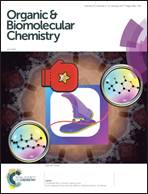Rhodium-catalyzed C–H functionalization with N-acylsaccharins†
Abstract
A rhodium-catalyzed C–H functionalization with activated amides by decarbonylation has been developed. Notably, this is the first C–H arylation employing N-acylsaccharins as coupling partners to give biaryls in good to excellent yields. The highlight of the work is the high tolerance of functional groups such as formyl, ester, and vinyl and the use of a removable directing group.



 Please wait while we load your content...
Please wait while we load your content...